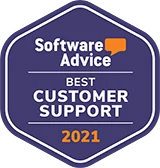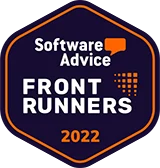The e-commerce explosion in recent years has forced many equipment rental companies to adapt. Customers want the option to research, browse, and pay for rentals online, just like they purchase things. So whether you've run a rental business for years or just entering the space, it's essential to have your own website to meet customer demand.
Thankfully, establishing an online presence for your rental equipment company has never been easier — or more cost-effective.
This article will provide you with a simple, step-by-step guide that will help you get a professional and functional website up and running in no time. All you'll need to worry about is ensuring you've got the supplies to meet demand!
Benefits of having your own website
Each year, more customers are turning online for their shopping needs. Whether it's buying things, booking a rental property for a holiday, or increasingly, booking equipment for rent to meet temporary needs.
While running a rental equipment company without an online presence is possible, you'd be leaving a lot of money on the table. Customers want to explore, learn, and see the equipment before renting it, and a direct booking website is a perfect way to facilitate that.
However, the benefits of having a rental booking website aren't limited to giving your customers what they want. There are several benefits for your company too.
More bookings: A rental website gives you a web presence that will be indexed on search engines like Google. You can use organic marketing or paid ads to drive interested customers to your site to get more bookings.
Open 24/7: A direct booking website is always open and available to take bookings — even while you're sleeping.
Time-efficient: A website with a direct booking possibility automates the booking process, saving you lots of time. When everything from asking for customer details to the payment is handled online, it frees up your time elsewhere and shortens the time it takes for your customers to check-in when picking up the equipment.
Reduce no-shows: An automated booking engine is an effective way to reduce revenue-eating no-shows.
Take deposits: A direct booking website can allow you to charge a deposit or the full total upfront, which improves cash flow and protects your company from damages.
Higher conversions: High-quality photos lead to more conversions because your audience can better understand the equipment you offer. Your website gives you more control over how your products are presented.
Integrated into your operations: A proper rental website is seamlessly integrated into your operations. The right tools help you manage inventory, orders, and other admin work, significantly reducing your workload. You can either build a website with a platform specialized in rentals, such as Twice, or create your site with a website builder and connect it to rental booking software.
Brand value: Having a website is like your digital shop window. Combined with your social media accounts, it's a powerful way to build brand awareness and engagement.
How to make your own rental website
As we can see, there are many benefits to having a direct booking website. Perhaps you've wanted to set up or redesign your website for some time, but you've been worried it will be too difficult, costly, or time-consuming.
The good news is that it's not hard to build a website, thanks to several rental website builders in the market. In fact, even popular website-building platforms, like WordPress, have become incredibly easy to use thanks to their no-code interfaces.
By following this simple step-by-step guide, you can establish a fully-functioning online presence that reduces customer inquiries and drives conversions.
What's more, with the right setup, you can manage your whole enterprise online. You can control payments and rental agreements, manage inventory, bookings, etc., directly from your computer or smartphone.
By streamlining or fully automating the rental process, you can reduce the pressure on your physical location and staff overheads, all while giving your customers the possibility to direct booking.
So, let's jump in so you can learn how to make a rental website in nine simple steps.
1. Choose a rental website builder
If you want to create a website for your equipment rental service, your first port of call is to choose a website platform. Thankfully, there are many user-friendly website builders out there that can help you achieve your goals without any HTML or coding knowledge.
In the past, website development was expensive, time-consuming, and required many technical skills. While there are still web developer puritans who build websites from scratch, there are easier ways on the market.
Benefits of a website builder
A website builder is perhaps the easiest and cheapest way to build a rental website. Most of these tools offer intuitive visual displays and drag-and-drop environments where you can make edits to your website. Adding text and other creatives like images, videos, and colors to your page is super simple with these tools.
Check out, for example, some of these website builders:
-
Squarespace (How to build a rental website with Squarespace)
-
Webflow
-
WordPress
-
GoDaddy
-
Weebly
To make your job easier and avoid the need to design everything from scratch, you can use templates available on different builders. Website templates are like pre-configured settings of a website and provide a raw version of the site you only need to edit for the content. You can even find specific rental website templates to make your job easier. These templates are designed to match the look and feel of other sites in the equipment rental space.
Additionally, most website builders come with integrations that add functionalities to the website. With the right set of add-ons and plugins, you can make your website work the way you want, in addition to looking the way you want. Rental businesses, for example, will need a booking system, a way to accept payments and charge deposits, and a system to manage circular inventory in real time. An e-commerce rental platform like Twice provides all these functionalities right out of the box.
You can use Twice either as a rental plugin you connect with your website builder or as a stand-alone website.
What's the best website builder for circular e-commerce?
Of course, depending on the equipment rental service you run, you might want to set up a site with more of an eCommerce vibe and functionalities. Many existing commerce platforms are more or less optimized for selling stuff, making it a bit of a hassle to set up a circular business model where the products need to return to the inventory.
For example, with Shopify, you'll get great tools for creating an e-commerce business, including many sophisticated features and third-party apps. While this option can work for some rental companies, it's not precisely what Shopify was built to do.
Therefore, a website builder with an integrated rental booking engine and management tools will give you the right amount of flexibility and control you need for your rental website and the admin tools you need to manage the operation in the back office.
2. Find a domain name and web host
Once you've decided which website builder you will use, it's time to move on to the next step: finding and registering a domain name and choosing a website hosting service.
Domain name
A domain name is simply the name of your website, like mywebsite.com. A domain name is a human-readable format of your website’s unique IP address. As a domain name’s purpose is to distinguish your website from other websites on the Internet, your domain name must be unique, recognizable, and relatable to your brand.
Many sites, like GoDaddy, allow you to check, register, and buy domain names.
Choosing a website name that matches your company name is a good idea. Something short, catchy, concise, and memorable is the best. So brainstorm a few ideas and see what custom domain name you can come up with.
Web hosting
Websites consist of text, images, videos, code, and other content that must be stored somewhere. Website hosting refers to storing all your website content on servers and showing them to users once they type in your web address into their browser. Every website needs to be hosted somewhere.
Many website builders offer hosting in their plans without additional costs – at least to a certain limit. If you run an exceptionally large or high-traffic website, you might need to purchase extra storage or bandwidth for your site to run smoothly.
Effectively, what you're buying is server space. However, it's money well spent because a good web host will ensure that your website loads quickly, is secure, and has consistent uptime and service. These factors are crucial for excellent user experience and organic search rankings.
You can choose several options when finding a place to host your rental website. However, only some have a reasonable cost-benefit ratio by any measure.
What's the best way to host a rental website?
As mentioned, there are several ways to host your website, from setting up your own servers to sharing a server with other websites. However, cloud hosting is the easiest and most scalable way to host your website. It's also what most website builders offer.
Cloud hosting makes websites accessible by storing content on a network of connected cloud servers. Unlike traditional hosting, your online presence is not dependent on a single server. Thus, you'll get more stability, flexibility, and scalability as your website grows.
So, especially if you're not a technical person, take advantage of the hosting services the website builder offers and focus on what you do best.
One last thing that you need to consider is whether your web host offers an SSL certificate. This functionality is essential for any business requiring user data and taking online bookings and payments.
With Twice, scalable cloud hosting is included in every plan. You also get a free domain provided by Twice, or you can choose to connect your own domain.
3. Design your website
Next, it's time to unleash your creativity as you get to design your website. At this stage, you might find some of these design thinking tools helpful.
The website design process has a few stages that significantly impact the user experience. In addition, the design phase lays the foundation for the potential growth of the website.
The first step of designing a website is to map out all the pages and develop the site structure. After this, you can move on to planning how navigating between the pages happens. Finally, you can design the page layouts and content. Ready-made website templates can be of great help in designing layouts. At the very least, they can serve as inspiration.
Organize your pages
We all know what a good website experience feels like. Everything is easy to find, and you always know where you are and what you are doing.
A website is a collection of individual website pages. These pages need to be organized and connected so that your users can navigate around and find the information they need. Building beautiful pages with excellent copy and photos are one thing, but they'll count for nothing if your users can't find them.
A good website structure can dramatically improve the user experience and is considered one of the most vital aspects of building a successful website.
There's no one-size-fits-all when it comes to the question of an ideal site structure. It depends on what you want to achieve with the site.
We have written a full guide on website structures. Check it out to learn more.
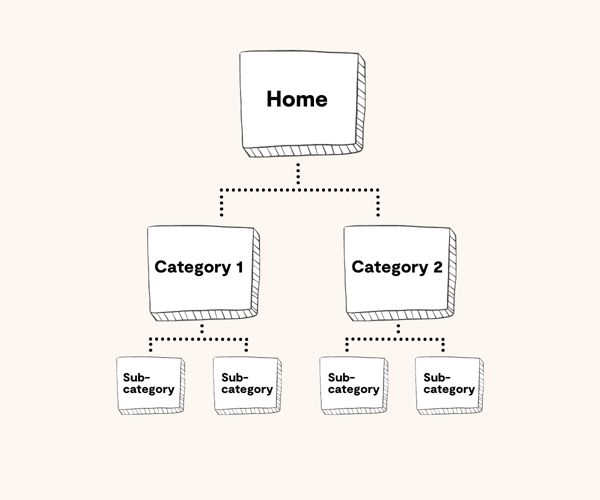
Make your website easy to navigate
Most rental websites have different pages for sections like categories, products, contact & about us, terms & conditions, blogs, and so on.
The way all these individual pages are tied together is called a website navigation system. Website navigations are built with different parts which have their role in improving the site's usability. The most common navigation elements are:
-
Header navigation
-
Sub-navigations
-
Sidebars
-
Call To Actions (CTA)
-
Internal links
-
Breadcrumbs
-
Sitemap
-
Search bar
You can read more about website navigation best practices from our guide.
How you link to each page is down to you, but it's worth pointing out that there is a certain way people are used to browsing websites. Starting to reinvent the wheel in website navigation might not be the best idea.
Once you have mapped out your pages, you will probably be able to identify some more essential and some less critical (but still necessary) pages. You want to show your most important pages or sections first and make them directly accessible from your home page.
The deeper your visitors can browse, the more important it becomes to implement elements that help visitors get back to where they started, such as breadcrumbs and always-visible head navigation.
Whichever way, having a clear structure designed in advance will help you tremendously in building a user-friendly navigation system. Think about your typical users and what they want to achieve when they come to your website. What stages do they have during the purchase journey? And how can you make the purchase as easy as possible when the user has made her decision?
A good rule to remember is to minimize the number of clicks a customer needs to use to achieve their aims. Common sense usually goes a long way. Show your most popular categories first. Steer users in the right direction with call-to-actions and by recommending relevant products. And lastly, make sure that the checkout is fast and straightforward.
Choose how to lay out the content
With the website's structure and navigation designs, you have your website's skeleton ready. Next, it's time to design how the content is arranged, positioned, and shown on your pages. This act is called layout design.
The website layout has a significant impact on how people interact with the content of a website. The layout design lets you control the relationship between different page elements and guides the user experience. A good website layout points your visitors intuitively in the right direction and sections that matter the most. As the browsing continues, the aim of layout design is to guide users through the following sections in the order of priority.
As a visual interface, a website layout can enhance your brand identity and make the website appealing to your target audience. Common layout choices include, for example:
-
Fullscreen image
-
Single column
-
Split screen
-
Asymmetrical
-
Boxes
-
Cards
It's also worth noting that one page can contain several sections with different layouts.
How to design a website layout
Websites with different purposes operate with different sets of rules regarding how creative you can get when designing the layout. An e-commerce site's primary goal is to sell a company's products and services, which is different from, e.g., news and media sites. That sets certain limitations for the approach and freedom you have.
E-commerce stores often combine full-screen, split-screen, box, and card layouts between sections.
A full-screen image (or even video) is great for highlighting your most important content and is typically used in the hero section of a page.
The split-screen layout is perfect when your site is split into two equally important sections. A classic example is to split an online clothing store based on gender.
Boxes are a versatile way to present, for example, different product categories and direct the visitor to the desired page.
Cards are a bit like boxes but are a tad more compressed. Thus, they work great on product listing pages that need to display a lot of products with equal hierarchy.
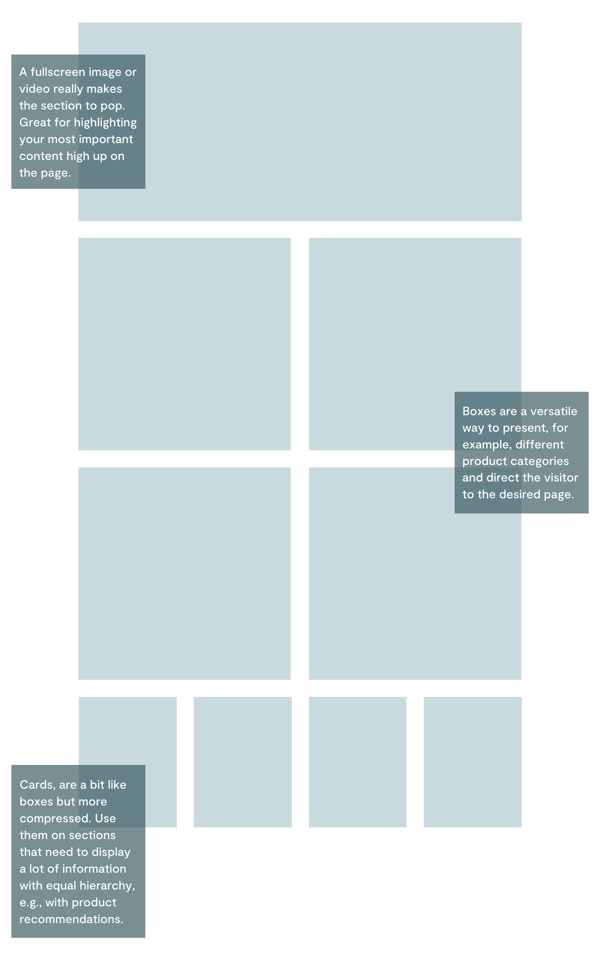
4. Prepare your website for online bookings
You need more than just a beautiful website and rich content to do business online. You need tools to make all product information and available booking slots visible on the website. Furthermore, people must have a way to book and pay for your products and services online. Otherwise, your website ends up being only your company's digital brochure.
To allow people to directly book and buy through your website, you need an e-commerce platform with both website and commerce features. Alternatively, you can use a separate website builder and a set of selected add-ons. Next, let's navigate through the key differences between building a direct booking website using an all-in-one platform versus using a website builder and a set of plugins.
To be fair, the difference between today's most popular e-commerce platforms and website builders is like a line drawn in water. Companies from both fields offer at least essential tools for building websites and selling online.
Using a rental e-commerce platform
The benefit of using an all-in-one commerce platform is that such a service offers a wide range of features to run your entire business. The website building features may not be as sophisticated as with companies specified in that area, but usually, they are sufficient to comply with the essential needs.
The lack of advanced website building and design features may be a low price to pay for having your whole business managed in one place and ensuring your entire operation runs smoothly end-to-end.
With an all-in-one platform, you can create an e-commerce website and host your product, inventory, order, and customer information in one place. Every time you add new products to your offering, you can publish them directly or schedule them to appear on your website. Therefore, you get a lot of synergies when the management tools and sales channels are natively integrated with each other.
Using a Website builder and add-ons
Another good option, especially if you want to have more control and customization options over your website's design, is to build your setup using a website builder to build the site and install relevant apps and plugins that integrate the online transactions seamlessly into your processes.
At this point, you have probably selected the website builder, designed the site structure, and even added some content to your website. However, it's the add-ons that add the extra layer of functionalities that allow your customers to buy from you online. A booking widget is the most essential plugin a rental business needs to look for. A good booking widget turns your product pages interactive, so your customers can make bookings directly on your website without, e.g., calling or emailing you. Furthermore, it calculates stock availability ensuring don't get double bookings.
The downside–or at least a minor inconvenience–is that you need to manage your website in one place and your business operations in another. And even though installing external apps is pretty straightforward, it might require some technical knowledge to get them to look and work the way you want on the website.
5. Add and create the content
A website is nothing without content. We've already outlined some of the core areas a direct booking website needs, such as great design, UX, and tools that make shopping through your site possible.
When creating content, there are two things you need to concentrate on: copywriting and visuals.
Copy
Next up, you'll need to add copy – a.k.a text – to your website. This is an important step because copywriting helps your customers understand what your business is about and how doing business with you works in practice. Furthermore, tone of voice is strongly linked to how people perceive your brand. Whether you want to sound playful, rebellious, provocative, or neutral - it's up to you.
The key to good copy is to keep things easy to read but information-rich. Large blocks of text are intimidating for quick browsing. So try to break down information into bite-size chunks of plain language.
Copywriting is particularly important on your product pages. Spend time honing the product descriptions and remember keyword optimization. Not only do product descriptions help customers learn more about the product, but product pages can be one of the most important sources of organic traffic.
Additionally, break each page using easily scannable formatting, like H1 and H2 headings, short paragraphs, bullet lists, etc. This work is vital for writing SEO-friendly pages, but it also gives you a much cleaner and easy-to-read website.
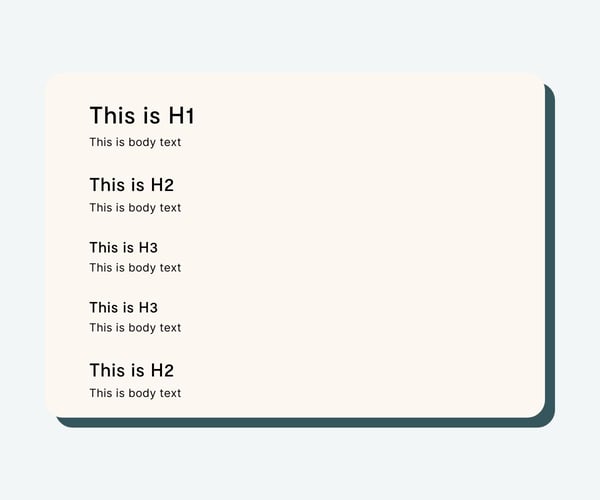
Visuals
While people come to your website to read and find information, it needs to make an impact on a visual level. Product specs are good, but good pictures sell your items. Where possible, shoot your own product photos. That way, you can achieve a consistent aesthetic across your website.
Additionally, some products will sell better with video. Remember, your customers need to feel assured that each product they rent suits their needs. So use your best judgment here.
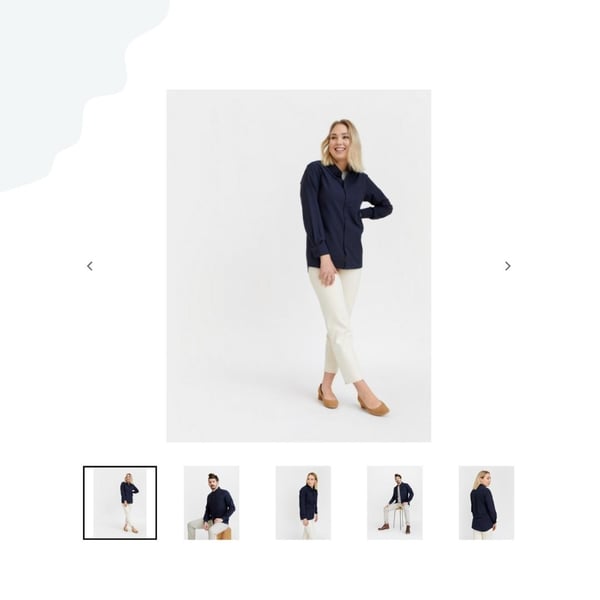
Finally, even if you're using a ready-made website template, this is the time to make it fit your brand. So, do things like select the right colors, choose the typography that matches your brand's style, add your logo, and do other simple customization tricks.
6. SEO optimization
Driving organic visitors to your site should be part of your marketing strategy. Paid ads are a great way to get bookings, but they cost money and can only be scaled to a certain point. On the other hand, SEO optimization will mean that you can produce a steady stream of customers who find your business via Google or other search engines.
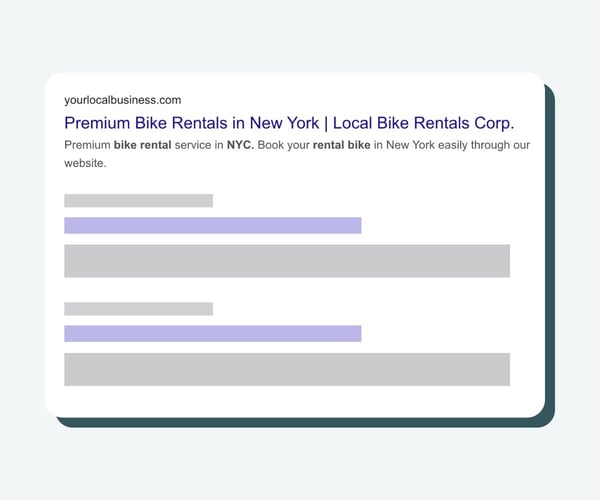
To give your website the best chance of being indexed near the top of Google's search engine results page (SERP), you need to structure your information correctly and ensure your website is technically optimized for good performance.
Some of the elements that will help your website rank well are:
Meta title: A meta title should be a 50-60 character long title for the page
Meta description: The meta description should be around 160 characters and provide a summary of the content and purpose of the page.
Alt-text for images: Any image on your website should have an alt-text that explains the image context. This helps visually impaired users – and Google's crawling robots – to understand your pages.
Page speed: Page speed is an influential ranking factor. Don't overload each page with images and videos, complex themes, plugins, or other features. Additionally, always optimize images for the web and use a good web host so your pages load quickly.
Responsiveness: Your users will access your site from smartphones and computers. Ensure your pages are responsive, usable, and look good in all screen sizes.
7. Social proof
Recommendations and guest reviews are powerful ways to create social proof and increase the trustworthiness of your website. They also work as a significant ranking factor for local recommendations on Google.
Every time your customers have had a great experience with you, ask them to leave a review on a relevant platform.
For example, Google reviews are a powerful tool businesses can use to their advantage for local SEO. Reviews can give potential customers an idea of what it's like to do business with you; as such, they're a valuable source of information.
But don't limit the collection of online reviews to Google only. In addition to Google reviews, reviews on other sites matter as well. Pages like Facebook, Yelp, Tripadvisor, and Trustpilot are good additions to your review palette when making sense in your industry.
Make soliciting customer reviews a habit for you and try to automate as much as possible. The key to getting more reviews is to make it as easy as possible for your customers.
8. Add analytics and conversion tracking
Once you've built the website and added content, it's time to set up website analytics and conversion tracking. You can take several approaches here, but Google Analytics is the most popular.
Analytics is an excellent way of gaining insights into your customers and website KPIs. For example, You can measure how many visitors you have and what pages they click on. Understanding this information means you can optimize the experience for future and potential guests to your site.
Adding Google Analytics requires you to set up an account and add the Analytics ID to your website.
You can use the information you generate to inform your marketing plan. For example, you can understand where your traffic sources come from, and what devices your visitors are using, track conversion, and recognize which campaigns give the best return on investment.
Setting up Analytics is the first step to getting the full picture of your website's performance. To track your sales and conversions, you need to install tracking codes of the advertising platforms you use to drive traffic to your website.
Google Tag Manager is an excellent tool to manage all the additional scripts you add to your site in one place. It's like a container that holds information from different data sources. When using Tag Manager, you only need to install the Tag Manager container ID to your website's every page instead of installing every tracking code one by one to your site.
Furthermore, you can create events and triggers in Tag Manager and start measuring the performance of your Google Ads, Facebook, and other campaigns.
9. Launch
Congratulations, it's time to launch your website out into the world. However, your work is never really done. Your rental website will need regular adjustments and continuous work to optimize its performance.
Your biggest concern at the beginning is getting your website in front of your users. You can take many different marketing approaches, but here are the low-hanging fruits.
Paid ads
Platforms like Google, Facebook, Twitter, and many more offer the possibility to advertise your business on their media. These can be search ads, video ads on YouTube, display ads on these platforms' ad networks, or targeted ads that appear on your target audience's social media newsfeed.
The platforms will serve targeted ads to people based on the demographic or location information you select. You can also upload customer lists and create lookalike audiences based on their demographics or simply retarget your website visitors who didn't convert on their first visit.
→ The benefits of Facebook advertising
Paid ads are a great way to get quick results. However, you need to offset the revenue they generate against the cost of paying for ads.
Organic marketing
Organic marketing involves producing content to attract an audience. You can write blogs, do YouTube videos, grow your audience on social media, or even hire influencers.
The main thing to do is define your ideal audience. Figure out where they hang out and find a way to get your message in front of them.
This approach takes longer to produce results, but the effects are long-lasting.
Other ways to promote your website
Of course, paid and organic marketing are not the only ways to boost your online visibility. There are, for example, numerous industry-specific listing sites where you can add your company.
Furthermore, being active in real life and building a strong brand helps your online marketing efforts. You can consider arranging or participating in events, starting a loyalty program, advertising in local newspapers, etc.
There are only so many ways to promote your business you can think of. So keep your mind open, try new ideas, and be creative!
Conclusions
If you follow all our steps, you'll have a direct booking website up and running in no time. You can use a rental website builder or a CMS, register your domain, and find a web host to quickly get things up and running. However, rentals differ from one-way e-commerce, so it's worth exploring rental software solutions.
These applications integrate with your website and allow you to manage inventory, fulfill orders, and gather lots of data that can help optimize your operation.
No matter what you rent, consumers want a straightforward way to make direct bookings, browse items, and pay for everything online. So take advantage of the great tools and get your equipment rental website live and ready to make extra money for your business.







